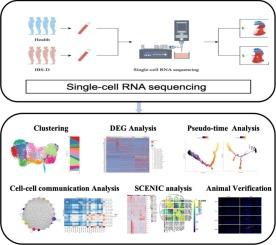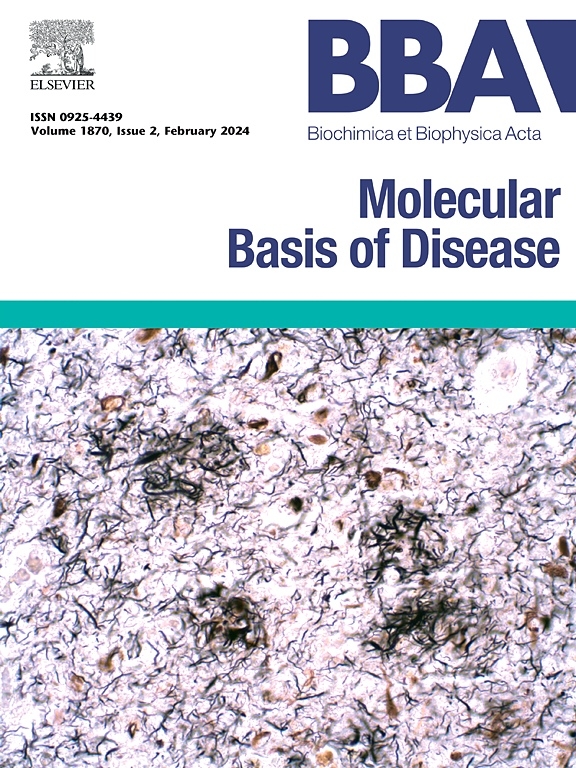单细胞RNA-seq揭示了腹泻-肠易激综合征患者的免疫谱变化。
IF 4.2
2区 生物学
Q2 BIOCHEMISTRY & MOLECULAR BIOLOGY
Biochimica et biophysica acta. Molecular basis of disease
Pub Date : 2025-05-31
DOI:10.1016/j.bbadis.2025.167945
引用次数: 0
摘要
背景:以腹泻为主的肠易激综合征(IBS-D)以反复腹痛和慢性腹泻为特征。T淋巴细胞在肠道炎症和免疫反应中起着至关重要的作用,可能在IBS-D的病理生理中起着重要作用。然而,T淋巴细胞影响IBS-D的确切机制尚不清楚。IBS-D所涉及的确切途径和相互作用仍有待确定。方法:对4例IBS-D患者和4例健康对照者的血液样本进行单细胞RNA测序。在数据预处理之后,我们进行了后续的生物信息学分析。此外,利用ELISA和三参数荧光分析IBS-D大鼠模型的血清和结肠组织样本,进一步阐明与IBS-D相关的T淋巴细胞格局。结果:共有45649个细胞被分为四种不同的细胞类型。其中,T淋巴细胞进一步细分为20个独特的簇。在T淋巴细胞中发现了高表达的新标记物。通过轨迹分析观察HIF-1α通路、nf - κ B通路和IL-17信号通路的失调。此外,单细胞调控网络推断和聚类分析显示FOS信号通路是IBS-D的潜在治疗靶点。此外,我们在IBS-D大鼠模型的血清和结肠组织中检测到PLK3和NFKBIZ水平异常升高。我们的研究绘制了可能影响IBS-D病理生理的T淋巴细胞通讯图谱。结论:本研究揭示了新的分子特征,并确定了IBS-D中T淋巴细胞的潜在治疗靶点,从而促进了我们对该疾病的理解并扩大了治疗选择。本文章由计算机程序翻译,如有差异,请以英文原文为准。

Single-cell RNA-seq reveals the immune profile changes in patients with diarrhoeal-irritable bowel syndrome
Background
Diarrhea-predominant irritable bowel syndrome (IBS-D) is characterized by recurrent abdominal pain and chronic diarrhea. T lymphocytes, which play a crucial role in gut inflammation and immune responses, may significantly contribute to the pathophysiology of IBS-D. However, the exact mechanisms by which T lymphocytes affect IBS-D remain unclear. The precise pathways and interactions involved in IBS-D are still to be determined.
Methods
We conducted single-cell RNA sequencing on blood samples from 4 IBS-D patients and 4 healthy controls. Following data preprocessing, we conducted subsequence bioinformatics analysis. Additionally, serum and colon tissue samples from IBS-D rat models were analyzed using ELISA and three-parameter fluorescence to further elucidate the T lymphocytes landscape associated with IBS-D.
Results
A total of 45,649 cells were classified into four distinct cell types. Among them, T lymphocytes were further subdivided into 20 unique clusters. Novel markers that were highly expressed in T lymphocytes were identified. Dysregulation of HIF-1α pathway, NF-kappa B pathway, and IL-17 signaling pathway, were observed through trajectory analysis. Additionally, single-cell regulatory network inference and clustering analysis revealed the FOS signaling pathway as a potential therapeutic target for IBS-D. Furthermore, we detected abnormally elevated levels of PLK3 and NFKBIZ in the serum and colon tissues of the IBS-D rat model. Our study mapped the communication atlas of T lymphocytes that may influence the pathophysiology of IBS-D.
Conclusions
This study uncovers novel molecular features and identifies potential therapeutic targets of T lymphocytes in IBS-D, thereby advancing our understanding of the disease and expanding treatment options.
求助全文
通过发布文献求助,成功后即可免费获取论文全文。
去求助
来源期刊
CiteScore
12.30
自引率
0.00%
发文量
218
审稿时长
32 days
期刊介绍:
BBA Molecular Basis of Disease addresses the biochemistry and molecular genetics of disease processes and models of human disease. This journal covers aspects of aging, cancer, metabolic-, neurological-, and immunological-based disease. Manuscripts focused on using animal models to elucidate biochemical and mechanistic insight in each of these conditions, are particularly encouraged. Manuscripts should emphasize the underlying mechanisms of disease pathways and provide novel contributions to the understanding and/or treatment of these disorders. Highly descriptive and method development submissions may be declined without full review. The submission of uninvited reviews to BBA - Molecular Basis of Disease is strongly discouraged, and any such uninvited review should be accompanied by a coverletter outlining the compelling reasons why the review should be considered.

 求助内容:
求助内容: 应助结果提醒方式:
应助结果提醒方式:


